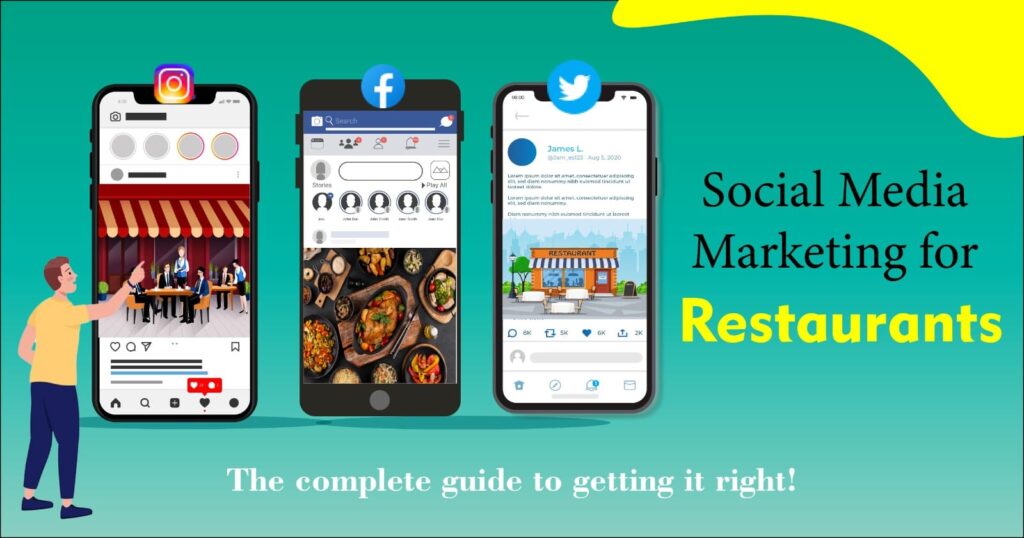How can restaurant owners harness the power of social media ?
In today’s day and time, social media is an indispensable part of human existence. Any big business, if it wishes to survive in today’s day and time, needs to use it and the restaurant industry is no stranger to the same. With a large number of dynamic clients on various platforms, these sites present themselves as an interface with their interest group, fabricate brand mindfulness, and drive client commitment. If you own an eatery and want to know how social media can be used for the same, then this blog is surely for you.
Table of contents
I. Understanding the Social Media Landscape
II. Defining a Social Media Strategy
III. Creating Compelling Content
IV. Leveraging Platform-Specific Features
V. Engaging with the Audience
VI. Utilizing Paid Advertising
VII. Analyzing and Measuring Success
I. Understanding the social media landscape
While social media platforms have been around since the year 1997, their popularity had only grown in the year 2004 with the rise of Facebook and Myspace. Within a few years of their launch, these became popular globally and soon after, in 2010, became places from where people began to disseminate information. The Arab Springs and the Occupy Wall Street are testaments to the same.
At present, the most popular social media platforms are Facebook, Instagram, Twitter, YouTube, and LinkedIn. Each of them has their own user demographics, key features, and benefits. By understanding these platforms, restaurant owners can make informed decisions about which ones best align with their marketing goals and target audience.
II. Defining a Social Media Strategy
After deciding what social media platforms are important for your business, developing a solid social media strategy is crucial for restaurants to achieve their marketing objectives. To create the same, the following details are required. These include:
- Defining the restaurant’s unique brand identity and positioning.
- Setting specific, measurable, achievable, relevant, and time-bound (SMART) goals.
- Identifying the target audience and understanding their preferences.
- Conducting competitor analysis to gain insights and differentiate the restaurant’s social media presence.
III. Creation of Compelling Content
When it comes to Social Media, content is the king. Creating engaging content that resonates with the restaurant’s target audience shall take you to the pinnacle of social media marketing.
To create compelling content, the strategies which can be used are:
- Developing a content calendar and maintaining consistency
- Showcasing high-quality food photography and videography
- Writing captivating captions and incorporating storytelling techniques
- Experimenting with different content formats, such as live videos, stories, and polls
IV. Leveraging Platform-Specific Features
As mentioned earlier, every social media platform has got its own dynamics and unique features that restaurants can leverage to their advantage. Some of the strategies which can be used in social media platforms are :
- Instagram: Using hashtags, bringing in influencers, and using the Explore page
- Facebook: Creating compelling posts, using Facebook Groups, and running designated advertisements.
- Twitter: Building serious areas of strength for a voice, taking part in moving discussions, and giving constant updates.
- YouTube: Sharing instructional exercises, and background recordings, and teaming up with content makers.
- LinkedIn: Sharing idea authority content, and advancing business occasions.
V. Engaging with the Audience
Social media is a two-way communication channel, and restaurants can use it to foster meaningful connections with their audience. Some of the ways to do the same include:
- Responding to comments, messages, and reviews.
- Encouraging user-generated content.
- Using social listening to monitor brand mentions and gather feedback.
- Leveraging social media for customer service and issue resolution.dolor sit amet, consectetur adipiscing elit. Ut elit tellus, luctus nec ullamcorper mattis, pulvinar dapibus leo.
VI. Using paid matrices
While the priority must always be organic content, using paid advertisements at times is necessary as well. It can significantly amplify a restaurant’s social media efforts. Some of the strategies which can be used are:
- Identifying campaign objectives and target audience
- Setting up targeted ads on different platforms
- Monitoring ad performance and optimizing campaigns
- Budgeting and maximizing return on investment (ROI)
VII. Analyzing the performances
To refine and improve social media marketing efforts, it’s essential to analyze key metrics and track performance. Some of the ways to do the same include:
- Identifying relevant metrics and key performance indicators (KPIs)
- Using built-in analytics tools and third-party platforms for insights
- Making data-driven decisions and adjusting the social media strategy accordingly
VIII. Adopting the changing dynamics
With the world changing rapidly, both emerging and seasoned marketers must be accepting of changes and adapt to them accordingly. These include:
- Keeping up with platform updates and algorithm changes
- Exploring new features and formats, such as augmented reality (AR) filters or live shopping
- Embrace emerging platforms to reach new audiences.
Social Media has turned into a necessary part of the café marketing scene, offering gigantic open doors for development and commitment. By understanding the latest marketing scene, fostering a powerful system, making convincing substance, and utilizing stage explicit highlights, eateries can really use online entertainment for showcasing themselves and reaching new people on the web

